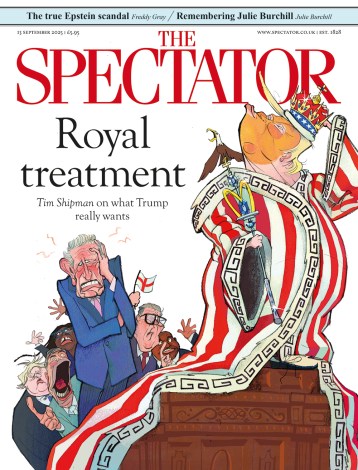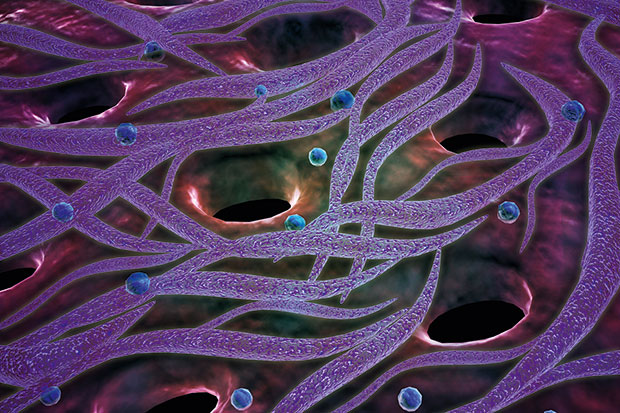It’s a modern pastime to hypothesise about what makes a good relationship. One evening not long ago in a Berlin bar, I listened to a friend diagnose how things were going with his partner: ‘We might have become a bit too symbiotic.’ Surprisingly earnest perhaps, but that’s what you get when a sociologist dates a psychoanalyst. On the way home, I wondered why symbiosis, apart from the obvious dangers of parasitism, might not be that desirable coexistence all our theories point toward. After all, the OED recommends that this ‘interaction between two different organisms living in close physical association’ is ‘typically to the advantage of both’. The darker side of symbiosis, I suppose, is the risk of losing yourself.
Yet the richest, riskiest symbioses are playing out inside you. The human body is home to 100 trillion microbes in mobile constellation (a mere 100 million stars, by comparison, make up the Milky Way). On our skin, encircling our orifices, throughout our guts and even within our cells, their genes outnumber ours by 500 to one. The changing census of these microbial presences (both tourists and residents) is our individualised microbiome. It is shaped by the food we eat, the company we keep, whether we were born vaginally or cut out of our mothers, fed from the breast or the bottle. A rough-and-ready measure of a healthy symbiosis is if our bacterial communities are not seen, smelt or felt. We ignore their mainly reliable, diligent and beneficial labour: they are our silent majority.
Recently scientists have started to make some noise about these bacteria who do more good than harm. On the final page of The Origin of Species, Darwin paid homage to the ‘grandeur’ of evolution as a ‘war of nature’. But Ed Yong is here to tell us that this is less than half the story. An even grander view of life includes the relations — animal and microbial — that are collaborative as well as combative. Yong leads us from a time before we peopled the planet, to the bottom of the ocean, into the pangolin enclosure at the zoo, and through the germ-free cages of lab-reared mice essential for the latest microbial research. I Contain Multitudes is a celebration of bacteriology’s coming of age, from germophobia to a new era of microbomania.
When scientific discoveries take place, they rarely appear as grand as they will later come to seem. In the mid-1600s, when the Dutch haberdasher Antony van Leeuwenhoek wasn’t cutting cloth, he devoted his evenings to making the world’s most powerful microscopes. ‘Almost everything he saw, he was the first human ever to see,’ from teaming life magnified in a drop of water to the ‘animalcules’ glimpsed in plaque scrapings from his own teeth. He was prepared to believe these exciting creatures could be both our friends and our foes, but unfortunately his microscopes were lost and so too the worlds they enabled humans to perceive. It’s not quite true that Carl Linnaeus went back to lumping the minutiae of microbial life under the label of ‘chaos’ in his 1730 taxonomy of living things, but Yong has a point that the next 150 years, microbially speaking, were quiet ones.
Nineteenth-century germ theorists —the European triumvirate of Pasteur, Koch and Lister — reignited the field, but tied bacteriology tightly to pathology. To them, microbes meant maladies. One pathogenic species caused one disease. Magic-bullet medicines were needed to take out single bacterial targets. When fine-tuned weapons weren’t forthcoming, Alexander Fleming’s discovery of penicillin led to the familiar ‘carpet-bomb’ approach of using broad-spectrum antibiotics to treat infection. To say germ theory misled us would be churlish; humankind has thrived in the wake of discovering how to hinder its enemies.
So when we gel our hands, spritz microbe-busting air-freshener and snuggle under an antibacterial duvet, are we at last safe? Well, in fact we may be making things worse. The hygiene hypothesis claims that indiscriminately limiting contact between bacteria and our bodies is making society weaker, sicker and maybe even fatter. And we are not just compromising ourselves. Yong’s approach is admirably zoological as well as medical. He shows why the geological epoch in which we live has been branded the Anthropocene. Human activity has disproportionately influenced (largely for the worse) the symbioses of the earth. Some bacterial ‘symbionts-in-waiting’, ready to set up partnerships when, for instance, a right-swiping finger touches a phone screen, are becoming endangered. Just as a shallower gene pool hinders species selection and diversity, so too does a smaller array of microbes.
It is only from today’s position of relative safety from pathogens, aided by the technologies of swabbing and sequencing, that humans can start to risk considering microbes as possible allies. In the West, infectious disease is no longer the leading cause of death. But to divide bacteria into two flavours — the baddies that make us sick and the goodies found in yoghurt drinks — is to oversimplify an intriguing mess. Microbes don’t have static identities, Yong emphasises, and they don’t behave the same in different parts of our bodies. What’s untroubling in the gut can burn through the urinary tract or, if we’re unlucky, run riot in the blood. This is sepsis, and this can kill you.
Given that a bacterial species’ activity is so dependent on space and time, scientists and DIY enema enthusiasts are busy tinkering, and sometimes transplanting whole bacterial communities, with varying levels of success. Yong is wary not to oversell our current state of knowledge. Microbes alone are unlikely to cure cancer or make poverty history. The bacterial profile of a disease-free subject seeded into a patient with diabetes is not yet able to restore them back to health. As the mantra goes, correlation is not causation. When you next see a product promising a cure-all boost for your gut, remember that microbial medicine relies on more than scatological mixology. Indeed, the long-term consequences of transplanting the only human organ that doesn’t require surgery to transfer — the microbiome — could, for all we know, be disastrous.
Nevertheless, Yong encourages us to dream big. Laboratories are working to engineer precise faecal mixtures, or ‘sham-poos’ if you will, to further develop the promising results clinicians have seen when treating the hospital superbug Clostridium difficile by bacterial exchange. The microbiome could prove to be the discipline-defying connection for which medicine has been searching, reminding doctors that their constructed specialties, from gastroenterology to psychiatry, are not immanent in the human body. Our bacteria know no such boundaries. Microbes appear to interact with our moods via a ‘gut-brain axis’. Unlike the sometimes blind faith with which SSRIs like Prozac are prescribed for a swathe of mental health problems, living psycho-biotic drugs might one day be tailored to an
individual’s particular anxieties and frailties.
I Contain Multitudes makes the importance of popularising science (a dirty word in some circles) sparklingly clear. Ed Yong and I took the same pathology course at the same university, though several years apart. I doubt the handouts have changed. His brave reimagining of the subject’s message from danger to possibility shows that medical educators can no longer afford to ignore the idea that microbes might be diseases’ cures as well as their causes. From his vibrant introduction to the witty endnotes, Yong’s expertise and narration hold no less wonder than a sacred text. You will certainly learn things you did not know, but he may also reawaken ideas you once had. The amazement I first experienced when learning about jumping DNA, which enables a bacterium to become ‘marbled with genes that arrived from its peers’, hit me again with even fuller force. Yong’s prose is alive with an almost incredulous pleasure that the field he has loved since childhood is now in vogue.
With a title borrowed from Walt Whitman’s most famous poem, you’d be forgiven for expecting that this literary favourite has been cherry-picked to give tricky science a more palatable flavour. But here, the allusion does philosophical work, provoking awe that we are host to, receive help from and are humbled by the life within us. The notion of a singularly healthy microbiome, like that of a prescriptively perfect relationship, is as cheap as an advertising jingle. Yet we are only just beginning to recognise how profoundly the bacteria we contain speak about our pasts, presents and futures. The song of myself is only complete with an accompanying choir of others.






Comments